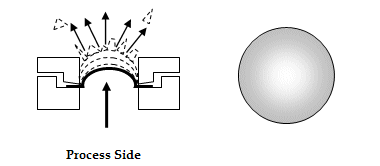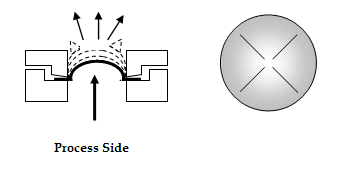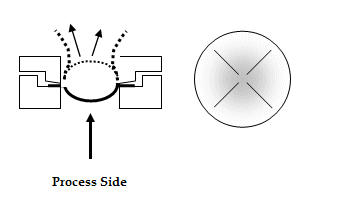Chemical and Process Engineering Resources

Rupture Disks for Process Engineers - Part 6
Nov 08 2010 01:30 PM | pleckner in Safety and Pressure ReliefTypes of Rupture Disks
The manufacturer can recommend the type of rupture disk that will best suit your application based on the information supplied. However, it doesn't hurt to have some knowledge
Forward Acting Solid Metal
This rupture disk is domed shape and installed such that the media is on the concave side of the disk (Figure 1). It can be used in systems where the Operating Ratio is at about 70% or less. It has a random bursting pattern which means it can be fragmenting (loose material) and thus cannot be used in combination with relief valves. This type of rupture disk can be used in vacuum or larger backpressure services but will require special supports to prevent reverse flexing. Its number one advantage is that it is cheap.
 |
| Figure 1: Forward Acting Solid Metal Rupture Disk |
Â
Forward Acting Scored Metal
This rupture disk is similar to its solid metal cousin (Figure 1) except that the disk is scored (Figure 2). Unlike the ill-defined bursting pattern of the solid metal design, this rupture disk has scored lines that will force the disk to burst along a fixed pattern. This design is a little more expensive but increases the useful Operating Ratio to about 85 to 90%. It also eliminates fragmenting, which means it can be used in combination with a relief valve. Also, there are many designs that allow this type of disk to be installed in vacuum environments without requiring special supports; it will still need special supports in high backpressure service to prevent reverse flexing.
Â
 |
| Figure 2: Forward Acting Scored Rupture Disk |
Â
 Forward Acting Composite
This rupture disk can be flat or domed and is comprised of a top section preceded by a bottom seal (Figure 3). The burst pressure is a function of these two sections. It is not uncommon for the bottom section to be of a totally different material of construction from that of the top section, even non-metallic. The domed disk design will burst due to pressure applied to the concave side whereas the flat disk design may bedesigned to burst in either direction!Â
 |
| Figure 3: Forward Acting Composite Rupture Disk |
Â
Â
Â
Slits and tabs in the top section control burst pressure and the bursting pattern. The flat construction can be used for the protection of low-pressure systems. Operating ratios are typically around 80% for the dome construction and 50% for the flat construction. This disk may require special supports to be used in vacuum or high backpressure conditions. Some designs are non-fragmenting, which means they can be used in relief valve combination.
Reverse Acting
This rupture disk is domed shape and installed such that the media is on the convex side of the disk (Figure 4). It is designed such that pressure pushes against the disk causing it to flex back into a forwarding acting disk and then burst. This rupture disk can be used in systems where the Operating Ratio is at about 90% or less. It can be, and very often is, manufactured to be non-fragmenting and thus is a good choice for use in combination with relief valves. This type of rupture disk can be used in vacuum or larger backpressure services without special supports.
 |
| Figure 4: Reverse Acting Scored Rupture Disk |
Â

 FB
FB

0 Comments